Key takeaways:
- Noise in photography, particularly in low-light conditions, can disrupt the intended mood and emotional connection of an image, emphasizing the need for noise reduction.
- Types of noise include luminance noise, chrominance noise, and color noise, each affecting image quality and clarity differently.
- Effective techniques for reducing noise involve using software like Adobe Lightroom, shooting at lower ISO settings, and employing exposure bracketing for better dynamic range.
- Noise reduction tools, such as Topaz DeNoise AI and DxO PureRaw, can significantly enhance the clarity and vibrancy of images, transforming noisy captures into impactful photos.
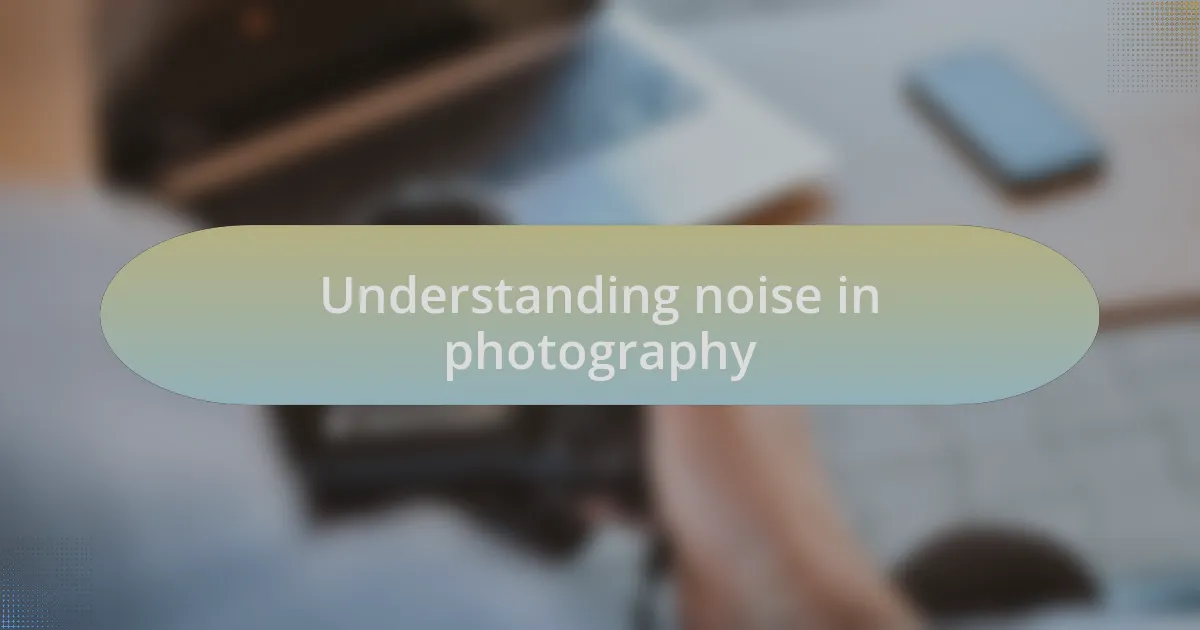
Understanding noise in photography
Noise in photography is typically perceived as unwanted grain that disrupts the purity of an image, especially in low-light situations. I vividly remember my first time using a high ISO setting on my camera under dim lighting. When I reviewed the images later, I was dismayed by the grain that rendered my once-sharp subject into a speckled mess. This experience made me realize that noise isn’t just an aesthetic issue; it can evoke emotions and impact how a viewer relates to the photograph.
The source of noise can vary—ranging from sensor quality, ISO levels, and even the conditions in which you’re shooting. Have you ever noticed how a photo taken at night feels different than one captured in bright daylight? A less advanced sensor struggles in low light, leading to increased noise and a gritty feel, which can detract from the intended mood of the shot. Personally, I’ve found that experimenting with lower ISO settings and proper exposure can yield significantly cleaner images, allowing the emotion I wish to convey to shine through.
Understanding noise is crucial for photographers looking to elevate their work. It’s worth asking yourself: how much do I want to embrace or eradicate noise in my images? In my case, I sometimes find that a bit of grain can add character, telling a story that a perfectly smooth image might miss. Balancing noise and clarity becomes a personal journey, shaping the narrative of the photographs we create.
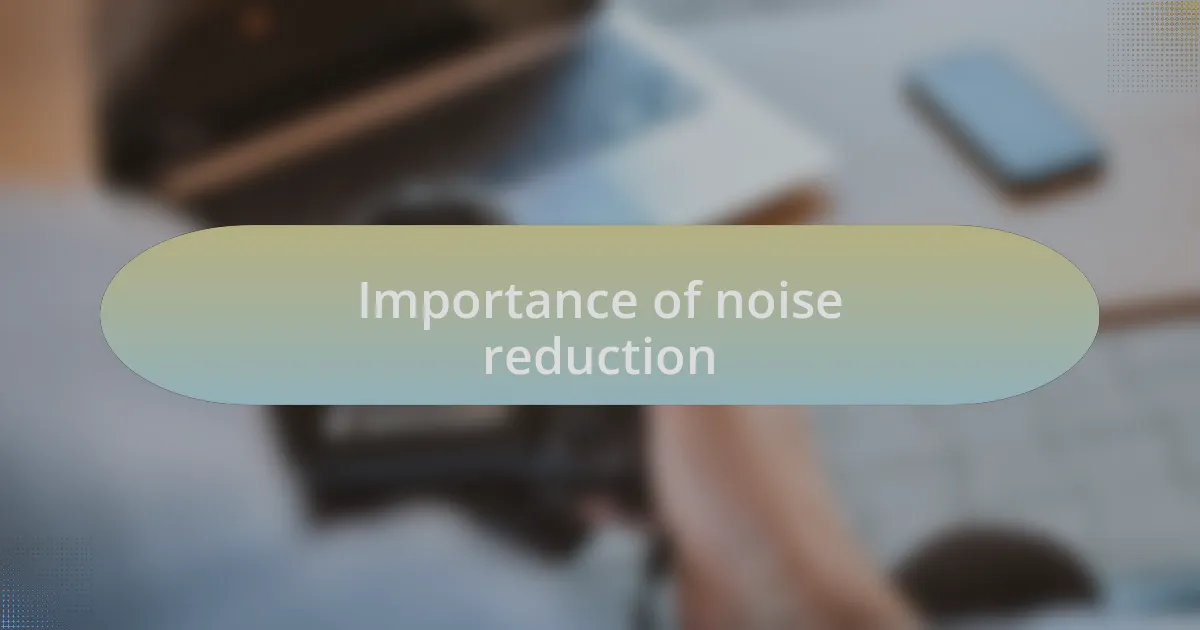
Importance of noise reduction
Noise reduction in photography is essential for preserving the integrity of an image. I recall a time while shooting at a bustling city street during twilight. The vibrant lights of the city reflected off the faces of passersby, but the noise in those images masked the vibrancy I wanted to capture. It made me realize that by effectively reducing noise, I could truly showcase the emotions and stories behind the scenes instead of letting unwanted distractions take center stage.
The significance of noise reduction also extends to the viewer’s experience. When I share my photos with friends, I want them to focus on the moment and emotion conveyed, not be distracted by grainy textures. Clean, noise-reduced images help guide the viewer’s eye and enhance the storytelling aspect of my work. It raises an important question: how do we help others connect with our visual narratives in the best way possible?
It’s not just about aesthetics; noise can subtly alter perceptions of quality and professionalism in photography. I’ve observed that my best images, those that resonate the most, often have been treated with some form of noise reduction. This process allows me to communicate my vision with clarity, evoking emotions and engaging the audience effectively—something I strive for in every shot I take.
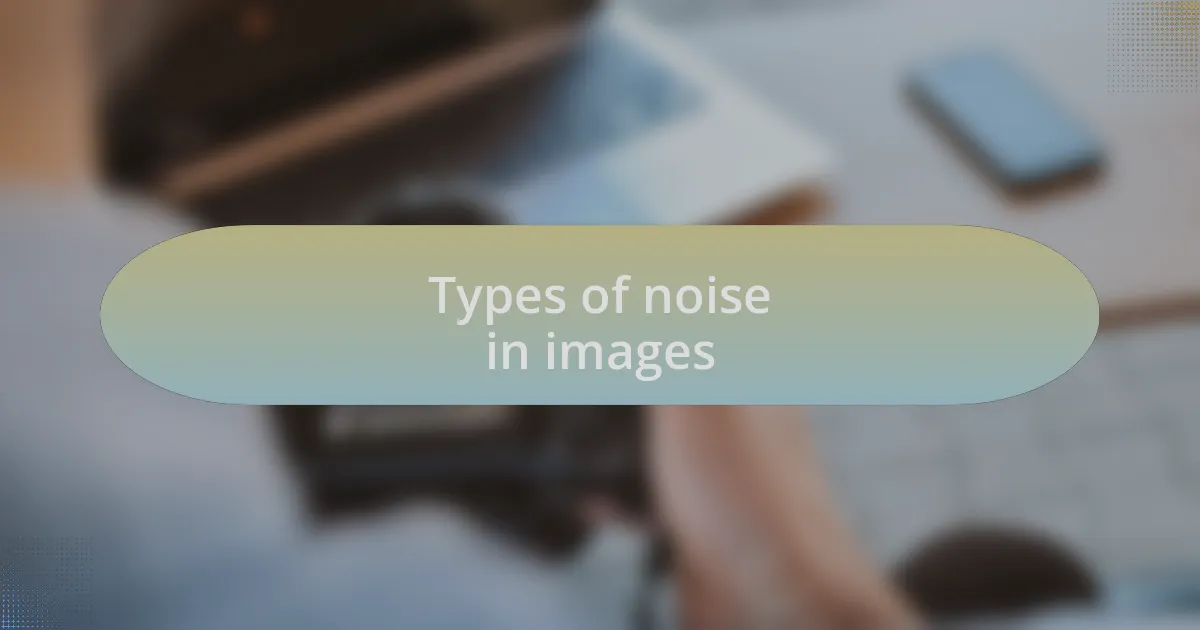
Types of noise in images
When we talk about noise in photography, we often encounter several distinct types. For instance, luminance noise is something I’ve grappled with, especially in low-light situations. This type manifests as variations in brightness, often appearing as grainy textures that can sneak into my images. It can be frustrating to see a beautiful composition, only to have it marred by this unwanted interference. Doesn’t it feel disheartening when your intended mood is disrupted by technical flaws?
Then, we have chrominance noise, which is notably troublesome because it introduces those unwanted color speckles into an image. I once took a photograph of a sunset, where vibrant hues turned into chaotic splashes of color due to chrominance noise. After I discovered how to effectively reduce it, the difference in the final image resonated with me profoundly. The sunset finally looked like the magical moment I had experienced, rather than a distorted memory.
Finally, let’s not overlook color noise, which typically stems from higher ISO settings. I vividly remember shooting on a foggy morning, attempting to capture the serene atmosphere. Unfortunately, the color noise turned picturesque scenes into a patchy landscape of hues. It pushed me to refine my noise reduction techniques, ultimately enhancing my ability to portray the emotion behind the shot. Have you ever felt that a perfect shot was diminished by a technical issue? It’s moments like these that truly teach us the value of understanding noise in photography.
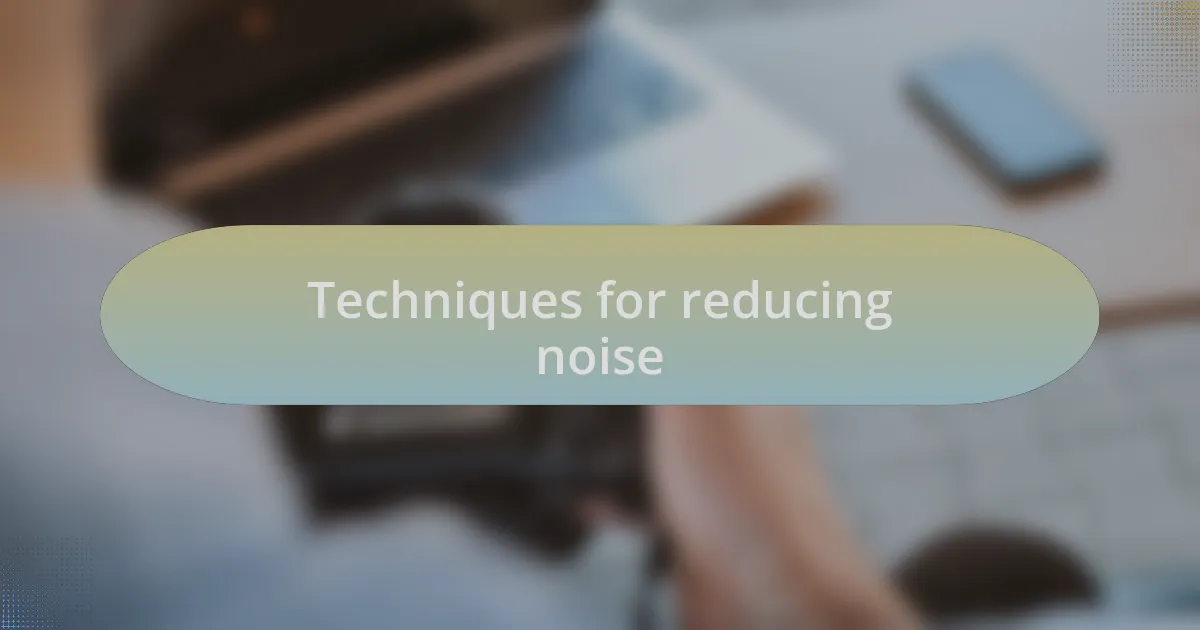
Techniques for reducing noise
To effectively combat noise, I often turn to noise reduction software during post-processing. Tools like Adobe Lightroom and Photoshop have become invaluable to me, as they offer advanced algorithms that analyze noise patterns. I remember going through some of my older low-light photos, applying these techniques, and feeling a wave of relief as I watched the noise dissolve, revealing clearer images that felt more true to my experience. Have you tried using software to reduce noise? The results can be transformative.
Another technique I’ve found useful is shooting at lower ISO settings whenever possible. One evening, while photographing cityscapes, I opted for a lower ISO and longer exposure times. The result was an image that not only captured the ambient glow but also maintained breathtaking clarity. Lowering the ISO might require a steadier hand or a tripod, but it’s well worth it when you see the rich details come to life without noise interference.
Finally, exploring the use of exposure bracketing has also been a game changer for me. By taking multiple shots at different exposure levels and blending them in post-processing, I can create a single image with reduced noise and improved dynamic range. I recall a rainy day where I experimented with this method, and the final result was jaw-dropping—every detail from the shadows to the highlights stood out. Have you ever considered trying exposure bracketing? It’s a practical approach that can elevate your photography significantly.
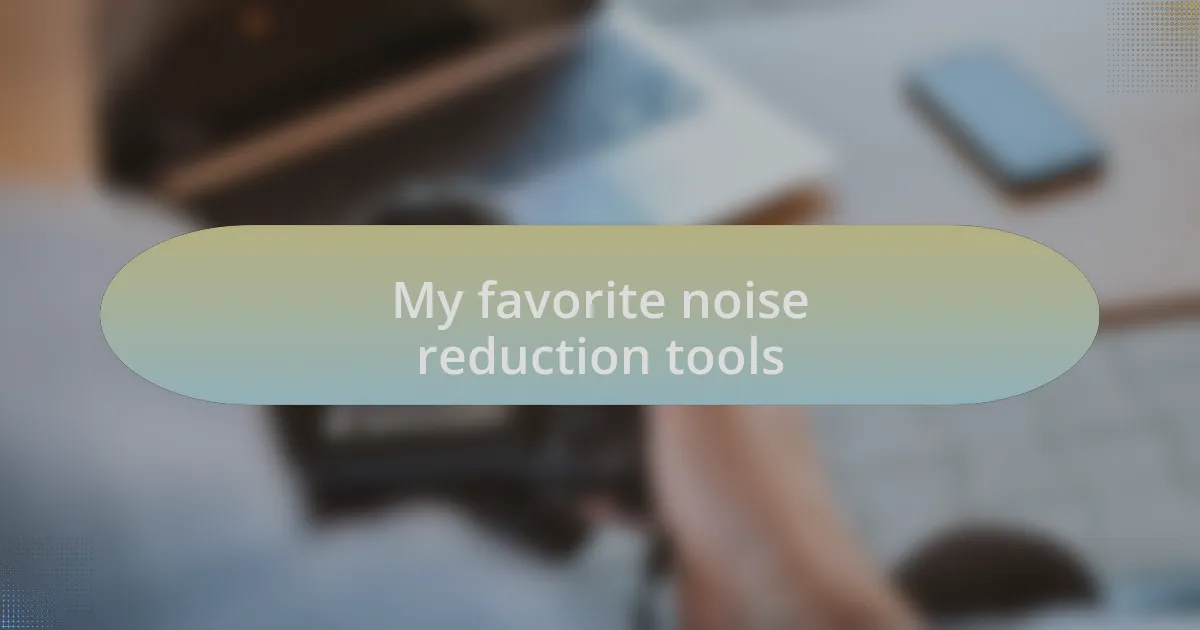
My favorite noise reduction tools
When it comes to noise reduction tools, one of my absolute favorites is Topaz DeNoise AI. The first time I used it on a night shot of a starry sky, I was genuinely amazed. Watching the software intelligently eliminate noise while preserving detail felt like magic. Have you experienced that relief when noise disappears, leaving a beautiful, clean image? It’s a game-changer for anyone who values clarity in their work.
Another tool I frequently rely on is DxO PureRaw. I remember applying it to some photos taken during a concert where the lighting was challenging. The enhancement it provided made those images vibrant and lifelike, restoring the energy of the moment. It’s remarkable how these tools can turn a noisy capture into a piece of art. Do you think software like this can truly elevate a photographer’s vision?
For editing directly within my workflow, I often use Lightroom’s noise reduction sliders. There was a time when I was hesitant to push the noise reduction too far due to fears of losing detail. But I’ve learned to embrace the sliders fully. Balancing corrections based on the image context has led to images I’m genuinely proud of. Have you found yourself experimenting with these settings? It can be an eye-opening experience that enhances your editing skills immensely.
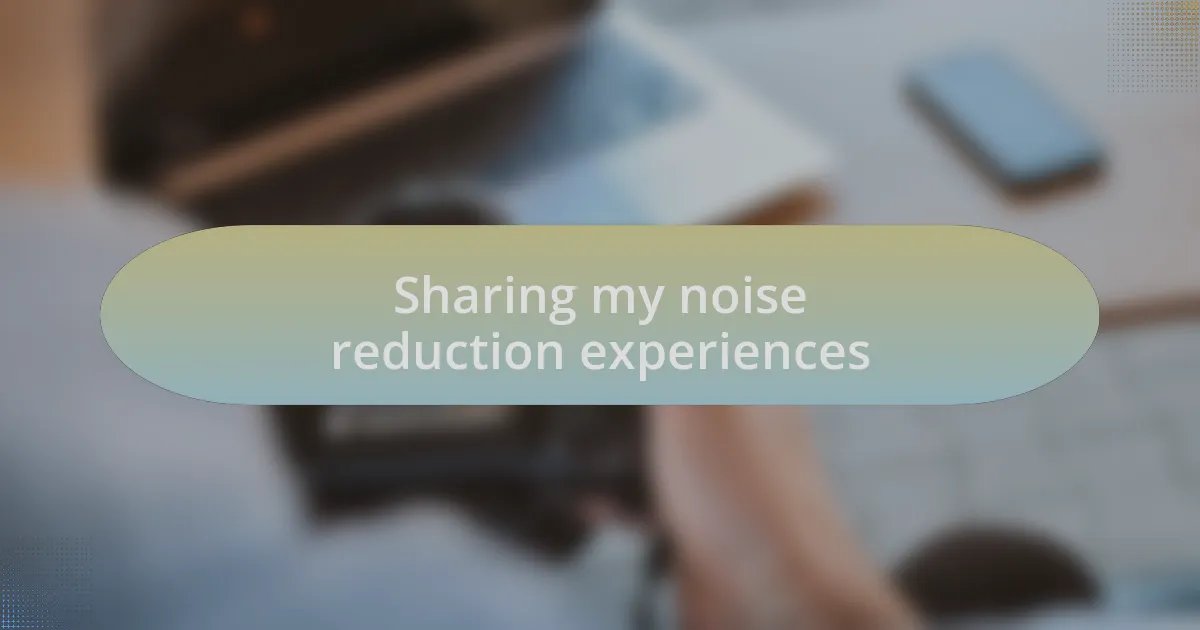
Sharing my noise reduction experiences
In my early days as a photographer, I encountered crippling noise in my low-light images. I remember a particularly frustrating evening at a café where the ambiance was perfect, but my photos suffered from excessive grain. That experience taught me the importance of understanding camera settings and inspired me to explore various noise reduction techniques, making me more intentional about my shooting conditions.
There was a memorable moment during a family event when I decided to capture candid shots in dim lighting. The noise was overwhelming, and I nearly deleted the images. Instead, I opted to apply noise reduction in post-processing and was astonished by the transformation. It reminded me how crucial it is to preserve memories, even when the original capture isn’t pristine. Have you had a moment where you turned a blurry, noisy photo into a cherished keepsake?
I also recall experimenting with multiple editing tools on the same noisy image to see which yielded the best results. It was enlightening to compare the outcomes side by side. Each tool has its strengths and weaknesses, reflecting how personal preferences shape our editing styles. Isn’t it fascinating how one image can inspire so many approaches? This process not only honed my skills but deepened my appreciation for the art of noise reduction.